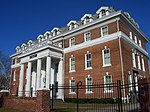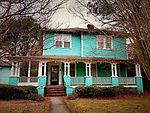Good Samaritan-Waverly Hospital

Good Samaritan-Waverly Hospital, also known as “Good Sam” Hospital and Waverly Hospital, is a historic hospital for African-American patients located in Columbia, South Carolina. It was built in 1952, and is a two-story, brick building in the Moderne style. The hospital housed a pharmacy, laboratory, X-ray room, staff dining room, two operating rooms, and 50 beds to service the local community. The hospital closed in August 1973.It was added to the National Register of Historic Places in 2008. In addition to its National Register of Historic Places status, the Hospital falls within the boundaries of Waverly Protection Area, a Preservation District within the City of Columbia Urban Design and Historic Preservation District system, as well as Waverly Historic District.
Excerpt from the Wikipedia article Good Samaritan-Waverly Hospital (License: CC BY-SA 3.0, Authors, Images).Good Samaritan-Waverly Hospital
Hampton Street, Columbia Waverly
Geographical coordinates (GPS) Address External links Nearby Places Show on map
Geographical coordinates (GPS)
| Latitude | Longitude |
|---|---|
| N 34.010277777778 ° | E -81.018888888889 ° |
Address
Good Samaritan Waverly Hospital
Hampton Street
29204 Columbia, Waverly
South Carolina, United States
Open on Google Maps









